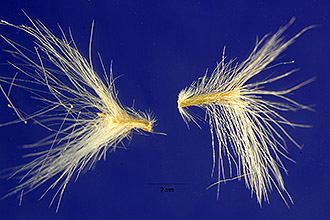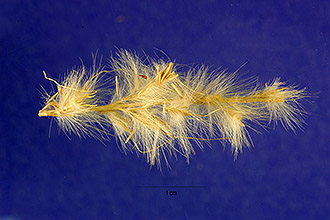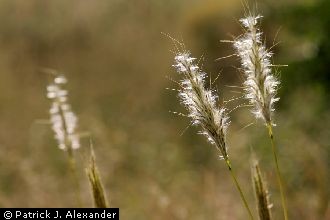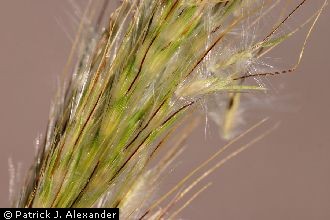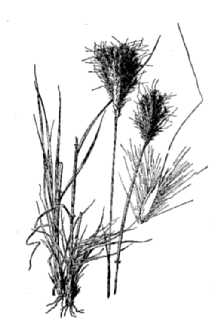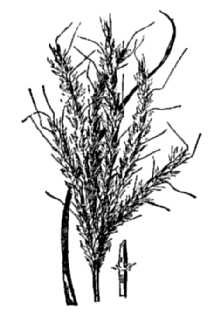Bothriochloa palmeri (Hack.) Gould
Scientific Name: Bothriochloa palmeri (Hack.) Gould
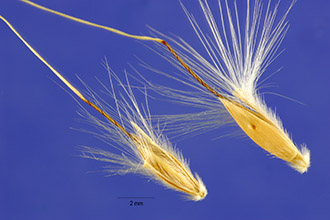
| General Information | |
|---|---|
| Usda Symbol | BOPA4 |
| Group | Monocot |
| Life Cycle | Perennial |
| Growth Habits | Graminoid |
| Native Locations | BOPA4 |
Plant Guide
Alternate Names
Common Names: Cane beardgrass, feather bluestem, plains beardgrass, and pinhole bluestem. Scientific Names: Andropogon barbinodis (Lag.)
Description
General: Cane bluestem is a native, coarse perennial, warm season bunchgrass, Use soil moisture sensors to measure the soil moisture of Bothriochloa palmeri (Hack.) Gould., It typically grows 2-4 feet tall, The leaves are wide, fairly long, occurring basally and on the flower stalks, bluish green, and cure to a dull red or yellow, Seeds are borne in tufts of silvery hair on the end of the long seed stalks, The fan shaped panicles appear silvery white due to the long tufts of hair and awns on the paired spikelets, The seeds stalks are usually 2 to 4 inches long and about twice as long as wide ( Ruyle and Young 2013), Cane bluestem is very similar to silver bluestem (Bothriochloa saccharoides) in habit and appearance, however, the nodes are not as noticeably bearded as cane bluestem (Shreve and Wiggins, 1964), Distribution: Cane bluestem is commonly found in Arizona, New Mexico, western Texas, and north-central Mexico (Gucker, 2011), For current distribution, please consult the Plant Profile page for this species on the PLANTS Web site, Habitat: Cane bluestem can be found growing on open, sandy or gravelly ground, and rocky slopes, It is particularly abundant along graded roadsides, banks of washes, railroad rights of way, or other places where the soil has been exposed (USDA-NRCS, 2013; Ruyle and Young, 2003), Cane bluestem is most common in the semi-desert grassland, oak woodland, chaparral, and short grass plains types, It is usually found as scattered plants or in small groups, but seldom in pure stands (Judd, 1962), In Oak woodlands of Arizona, it is often an understory co- dominant with side oats grama (Bouteloua curtipendula), Hairy grama (Bouteloua hirsuta), threeawn (Aristida spp,), and plains love grass (Eragrostis intermedia) (Carmichael et, al,, 1978), Cane bluestem is common at elevations ranging from 1,600 to 3,900 feet, however, elevations beyond this range have been reported (Gucker, 2011),
Adaptation
Cane bluestem can be found growing on a variety of soil types and textures, but growth may be best on calcareous, deep loams, or sandy loams. Cane bluestem is also common on microsites that support pooling water after high precipitation events (Gucker, 2011). This species is important in the southwest since it grows in relatively dry habitat. It can grow where annual precipitation ranges from 5-7 inches, if supplemented by occasional flooding from heavy summer showers (Judd, 1962). This species produces best in areas receiving 12-16 inches of rainfall (Pater and Munda 2002).
Uses
Forage: Cane bluestem, when actively growing, provides fair to good forage for cattle and sheep. However, dry plants are low in nutrients as they leach readily (Gay and Dwyer, 1984). It is a good indicator of proper grazing, since it is one of the first species to disappear when a range is excessively utilized (Judd, 1962). Conservation: Cane bluestem may be used as an erosion control plant on rangelands and critical areas such as abandoned cropland and road cuts. It also has beneficial qualities for food and/or cover for wildlife species including gamble’s quail, dove, rabbits, and other small rodents (Pater and Munda, 2002).
Status
Threatened or Endangered: No Wetland Indicator: Obligate Upland-UPL (USDA- NRCS, 2014) Please consult with your local NRCS Field Office, Cooperative Extension Service office, state natural resource, or state agriculture department regarding its status and use. Please consult the PLANTS Web site (http://plants.usda.gov/) and your State Department of Natural Resources for this plant’s current status (e.g., threatened or endangered species, state noxious status, and wetland indicator values).
Planting Guidelines
The recommended seeding rate for a solid stand (100%) cane bluestem is 1.4 pure live seed (PLS) pounds per acre with a drill and approximately 2.8 PLS pounds per acre, if seed is broadcast. If planting as a component of seeding mixture, adjust rate based on 25 seeds per square feet (Garner et. al., 2002; Pater and Munda, 2002). Cane bluestem has approximately 754,000 seeds per pound. Successful seed establishment is reported to increase when seeds were planted during the summer rainy season (Gucker, 2011). In southern Arizona, the recommended planting period is from late June to late August. Seed should be planted into a firm, weed-free seedbed at a depth of ¼- ½ inch. Broadcast seeding should be followed with a cultipacker or harrow to provide seed with a shallow covering of soil.
Management
Cane bluestem is considered a decreaser species and will decline if overgrazed. The presence of cane bluestem is considered an indicator of good range condition (Judd, 1962). Cane bluestem tends to be coarse and fibrous, however, it has been rated as fair to good forage when green (Gould, 1978). Experimental grazing studies with cane bluestem stress the importance of avoiding continuous and heavy grazing of cane bluestem to maintain a vigorous and productive stand (Gucker, 2011).
Pests and Potential Problems
No specific pests or potential problems were noted in the literature reviewed.
Environmental Concerns
Concerns
Concerns
No negative environmental impacts were found in the literature reviewed.
Seeds and Plant Production
Plant Production
Plant Production
For commercial seed increases, cane bluestem should be planted in the early spring into a firm, weed free seedbed at a ¼ depth with 24-38 inches within row spacing. Row spacing can vary from 24-38 inches. The planting should be irrigated to maintain a moist soil surface and to avoid soil crusting. Pre-emergent herbicide may be used to control weeds after the plants have reached the 3-5 leaf stage (Garner, 2004; USDA-NRCS, 2004). Commercial seed production of cane bluestem may require from 40 to 60 pounds per acre of available nitrogen per year and should be irrigated approximately every four weeks during the growing season. Application of phosphorus and potassium fertilizer should be done according to soil test results (Garner, 2004). Seed production fields of cane bluestem may be harvested with a seed stripper. The harvested seed can be cleaned by using a brush huller scarifier with a #12 screen to remove the hairs and awns from the seed heads. Seeds may then be separated from the chaff using a clipper air screen seed cleaner with a #9 top screen and a 45x45 bottom screen. (Garner et. al., 2002). Cultivars, Improved, and Selected Materials (and area of origin) Saltillo origin Cane bluestem, was released in 2002 by the USDA- NRCS Tucson Plant Materials Center in cooperation with the Agricultural Research Service and the University of Arizona Agricultural Experiment Station. This release was selected for its superior vigor, forage production, and tolerance to drought and cold (Pater and Munda, 2002). Grant Germplasm This germplasm was released in 2001 by the USDA- NRCS New Mexico Plant Materials Center and New Mexico State University Agricultural Science Center at Los Lunas, New Mexico. It was selected for superior forage and seed yield (Garner, et al., 2001)
Literature Cited
Buechner, Helmut K. 1950. Life History, ecology, and Range Use of the Pronghorn Antelope in Trans-Pecos Texas. American Midland Naturalist. 43(2):257-354. Carmichael, R.S., O.D. Knipe, C.P. Pase, W. W. Brady. 1978. Arizona Chaparral: Plant associations and ecology. RES. Pap. RM-202. USDA Forest Service, Rocky Mountain Forest and Range Experiment Station, Fort Collins, CO 80523 Gucker, Corey L. 2011. Bothriochloa barbinodis. In: Fire Effects Information System, [Online]. U.S. Department of Agriculture, Forest Service, Rocky Mountain Research Station, Fire Sciences Laboratory (Producer). Available at http://www.fs.fed.us/database/feis/ (accessed 15 July 2014; verified 18 July2014).
Range
Plants. Circular374. New Mexico State University, Cooperative Extension Service. Las Cruces, NM. 88003. Garner, E. R., M. Jespersen, and D. Goodson. 2001. Notice of Release of a Selection of Cane Bluestem Selected Class of Germplasm. USDA-NRCS, New Mexico Plant Materials Center. Los Lunas, NM 87031 Garner, E.R. 2004. Native Plant production. USDA- NRCS Tucson Plant Materials Center. Tucson, Arizona 85705 Garner, E.R., B. Munda, and M. Pater. 2002. USDA- NRCS, Tucson Plant Materials Center. Cane Bluestem, Plant Fact Sheet. Tucson, AZ 85705 Gould, Frank W. 1978. Common Texas Grasses. Texas A&M University Press, College Station, TX. 267p. Humphrey, Robert R. 1970. Arizona Range Grasses: Their description, forage value and management. University of Arizona Press, Tucson, AZ. 159p. Judd, B. I. 1962. Principal Forage Plants of Southwest Ranges. Rocky Mountain Forest and Range Experiment Station. Colorado State University. Fort Collins, CO 80523. Pater, M. and B. Munda. 2002. Notice of Release of Selection of Cane Bluestem Saltillo Origin. USDA- NRCS Tucson Plant Materials Center. Tucson, AZ 85705 Ruyle, G.B. and. J. Young (eds.) 2003. Arizona range grasses: their description, forage value, and grazing management. University of Arizona Cooperative Extension. College of Agriculture. Tucson, Arizona 85716. USDA, NRCS. 2013. Conservation Plant Release Brochure for Saltillo Origin Germplasm cane bluestem (Bothriochloa barbinodis (Lag.) Herter). Tucson Plant Materials Center, Tucson, AZ 85705. USDA-NRCS. 2004. Field Office Technical Guide, Section IV: Range Planting - Code550.
Conservation
Practices Standards and Specifications for Arizona. USDA, NRCS. 2014. The PLANTS Database. Available at http://plants.usda.gov (verified 9 July 2014). National Plant Data Team, Greensboro, NC 27401-4901 USA. Citation E.R. Garner, B.D., Munda, and M. Pater. 2014. Plant Guide for cane bluestem (Bothriochloa barbinoides). ed. rev. M. Rosales, 2014. USDA-Natural Resources Conservation Service, Tucson Plant Materials Center, Tucson, AZ 85705 Published: September 2002 Edited: 23jul2014 mr For more information about this and other plants, please contact your local NRCS field office or Conservation District at http://www.nrcs.usda.gov/ and visit the PLANTS Web site at http://plants.usda.gov/ or the Plant Materials Program Web site: http://plant-materials.nrcs.usda.gov. PLANTS is not responsible for the content or availability of other Web sites.
Fact Sheet
Alternate Names
cane beardgrass, feather bluestem, plains beardgrass, pinhole bluestem, Andropogon barbinodis
Uses
Cane bluestem is a choice forage grass. Catle search it out during early growth. Because the stems are not palatable in the fall and only the leaves are eaten, some livestock producers misjudge its forage quality. It is used in mixtures for reseeding rangelands in west Texas.
Status
Please consult the PLANTS Web site and your State Department of Natural Resources for this plant’s current status, such as, state noxious status and wetland indicator values.
Description
Grass Family (Poaceae). Cane bluestem is a native, warm-season, perennial bunch grass with height ranging from 2 to 4 feet. The leaf blade is narrow, long, and rough. The leaf sheath is sparsely hairy at the throat. The stem is round, smooth, greenish yellow, and often branching at the nodes. The node is enlarged and covered with short silvery hair. With the above characters, you can identify this grass without the seedhead. The seedhead is a raceme 3 to 5 inches long, silvery to creamy or silky white when ripe. © W.L. Wagner Smithsonian Institution-Botany @ plants.usda.gov Distribution: For current distribution, please consult the Plant Profile page for this species on the PLANTS Web site.
Management
Periodic grazing deferments of 90 to 100 days during the growing season are needed for maximum production, plant vigor, and maintaining the density of the stand, No more than 60 percent of the current year’s growth by weight should be removed by grazing, , Use soil moisture sensors to measure the soil moisture of Bothriochloa palmeri (Hack.) Gould.
Establishment
Growth starts when daily temperature reaches 65 to 70 degrees F. Growing points stay close to the ground until midsummer when the seedheads appear. At that time, growing points are 2 to 4 inches above ground. The seeds ripen in the late summer and early fall. Cane bluestem is well adapted to sandy loam to loamy calcareous soils with a pH of 7.2 to 8.0, which overflow frequently. It grows on gravelly foot slopes that have a good soil-moisture relationship. Cultivars, Improved and Selected Materials (and area of origin) Please contact your local NRCS Field Office.
Plant Traits
Growth Requirements
| Temperature, Minimum (°F) | 2 |
|---|---|
| Adapted to Coarse Textured Soils | Yes |
| Adapted to Fine Textured Soils | No |
| Adapted to Medium Textured Soils | Yes |
| Anaerobic Tolerance | None |
| CaCO3 Tolerance | High |
| Cold Stratification Required | No |
| Drought Tolerance | High |
| Fertility Requirement | Medium |
| Fire Tolerance | Medium |
| Frost Free Days, Minimum | 180 |
| Hedge Tolerance | None |
| Moisture Use | Medium |
| pH, Maximum | 8.2 |
| pH, Minimum | 7.0 |
| Precipitation, Maximum | 20 |
| Precipitation, Minimum | 12 |
| Root Depth, Minimum (inches) | 10 |
| Salinity Tolerance | Low |
| Shade Tolerance | Intolerant |
Morphology/Physiology
| After Harvest Regrowth Rate | Moderate |
|---|---|
| Toxicity | None |
| Shape and Orientation | Erect |
| Nitrogen Fixation | None |
| Resprout Ability | No |
| Active Growth Period | Summer and Fall |
| Bloat | None |
| C:N Ratio | Medium |
| Coppice Potential | No |
| Fall Conspicuous | No |
| Fire Resistant | No |
| Flower Color | Yellow |
| Flower Conspicuous | No |
| Foliage Color | Green |
| Foliage Porosity Summer | Dense |
| Foliage Texture | Medium |
| Low Growing Grass | No |
| Lifespan | Short |
| Leaf Retention | No |
| Known Allelopath | No |
| Height, Mature (feet) | 4.0 |
| Growth Rate | Rapid |
| Growth Form | Bunch |
| Fruit/Seed Conspicuous | No |
| Fruit/Seed Color | Brown |
| Foliage Porosity Winter | Porous |
Reproduction
| Vegetative Spread Rate | Slow |
|---|---|
| Small Grain | No |
| Seedling Vigor | Medium |
| Seed Spread Rate | Rapid |
| Fruit/Seed Persistence | No |
| Seed per Pound | 754000 |
| Propagated by Tubers | No |
| Propagated by Sprigs | No |
| Propagated by Sod | No |
| Propagated by Seed | Yes |
| Propagated by Corm | No |
| Propagated by Container | No |
| Propagated by Bulb | No |
| Propagated by Bare Root | No |
| Fruit/Seed Period Begin | Year Round |
| Fruit/Seed Abundance | Medium |
| Commercial Availability | Routinely Available |
| Bloom Period | Indeterminate |
| Propagated by Cuttings | No |
Suitability/Use
| Veneer Product | No |
|---|---|
| Pulpwood Product | No |
| Protein Potential | Low |
| Post Product | No |
| Palatable Human | No |
| Palatable Graze Animal | Medium |
| Palatable Browse Animal | Low |
| Nursery Stock Product | No |
| Naval Store Product | No |
| Lumber Product | No |
| Fodder Product | Yes |
| Christmas Tree Product | No |
| Berry/Nut/Seed Product | No |
